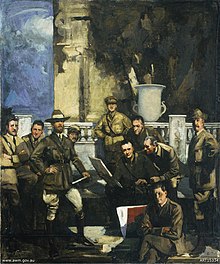George Washington Lambert
George Washington Thomas Lambert ARA (born September 13, 1873 in Saint Petersburg , Russia , † May 29, 1930 in Cobbity , Australia ) was an Australian artist, known for his portraits and as a war painter during the First World War .
Live and act
childhood
Lambert was born in Saint Petersburg, the posthumous son of George Washington Lambert (1833–1873) from Baltimore , Maryland . Lambert's mother was the younger Annie Matilda, née Firth, an Englishwoman. The mother and son soon moved to Württemberg , Germany to live with Lambert's maternal grandfather. Lambert went to Kingston College in Yeovil , Somerset . The family, consisting of Lambert, his mother and three sisters, decided to emigrate to Australia. On January 20, 1887, they arrived in Sydney on board the Bengal .
Early career
Lambert began exhibiting his pictures in the Art Society and the Society of Artists in Sydney in 1894. In 1895 Lambert began contributing ink cartoons for The Bulletin and worked full time as a painter from 1896. In 1899 he won the Wynne Prize with Across the Blacksoil Plains . Until 1900 he studied at Julian Ashton's art school in Sydney . He later won a £ 150 travel grant from the New South Wales government . He spent a year in Paris before moving to London , where he exhibited at the Royal Academy of Arts . In 1911 Lambert won a silver medal at an international exhibition in Barcelona for his painting The Sonnet . During this time he was well known as a portrait painter.
War painter

In 1917 Lambert became one of the official Australian war painters during the First World War. His painting Anzac, the landing 1915 of the landing on the Gallipoli peninsula in Turkey is the largest painting in the Australian War Memorial collection. Lambert traveled to Gallipoli as honorary captain in 1919 to make sketches for the painting.
During the war years he spent a lot of time in London. There he is said to have had a romantic relationship with fellow artist Thea Proctor .
Return to Australia
Lambert returned to Australia in 1921, where he was successful in Melbourne with a solo exhibition at the Fine Art Society Gallery . In 1922 he was elected a partner in the Royal Academy. He often visited the homestead of Colonel Granville Ryrie of the Australian Light Horse in Michelago, where he painted The Squatter's Daughter and Michelago Landscape . In 1927 he won the Archibald Prize , Australia's most prestigious art prize for portraits, with his work Mrs Murdoch . Lambert died in Cobbity near Camden in 1930 and is buried in the Anglican part of South Head Cemetery .
Private life

In 1900 he married Amelia Beatrice "Amy" Absell (1872–1963).
His sons were Maurice (1901–1964), a well-known sculptor and associate of the Royal Academy of Arts and Constant , composer and conductor . Lampert was also the grandfather of Kit Lambert .
Individual evidence
- ^ A b c d Martin Terry: Lambert, George Washington Thomas (1873–1930) . In: Australian Dictionary of Biography , Volume 9 . MUP . Pp. 649-650. 1983. Retrieved July 15, 2009.
swell
- Percival Serle: Lambert, George Washington . In: Dictionary of Australian Biography . Angus and Robertson, Sydney 1949 ( Dictionary of Australian Biography L [accessed July 15, 2009]).
Web links
- Artist profile of Goerge Washington Lambert in the Australian War Memorial
- Lambert exhibition, Gallipoli and Palestinian landscapes - Australian War Memorial (English)
- George Washington Lambert at Australian Art (English)
- George Washington Lambert in the database of Find a Grave (English)
| personal data | |
|---|---|
| SURNAME | Lambert, George Washington |
| ALTERNATIVE NAMES | Lambert, George Washington Thomas |
| BRIEF DESCRIPTION | Australian artist |
| DATE OF BIRTH | September 13, 1873 |
| PLACE OF BIRTH | St. Petersburg |
| DATE OF DEATH | May 29, 1930 |
| Place of death | Cobbity |

